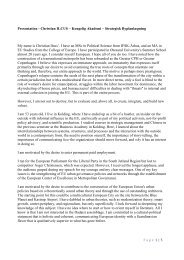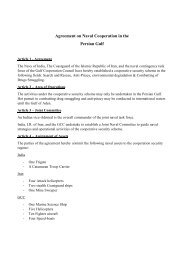china IR rev final sept 2023
This is the fourth and penultimate edition of my annotated bibliography on China international relations, art and Philosophy. from the books I distill policy relevant ideas for use and comsideration of policymakers after the ratification of the Cai, when the relatioship willl have to be managed
This is the fourth and penultimate edition of my annotated bibliography on China international relations, art and Philosophy. from the books I distill policy relevant ideas for use and comsideration of policymakers after the ratification of the Cai, when the relatioship willl have to be managed
Create successful ePaper yourself
Turn your PDF publications into a flip-book with our unique Google optimized e-Paper software.
economic and military might simultaneously. This has alarmed India, Japan, and Vietnam. Unless China’s leaders check<br />
their ambitions, a host of countries already forming tacit military coalitions will also start to impose economic<br />
restrictions. The book cites the coalescing against Germany as a model. Western strategists have sized on this historical<br />
lesson in countering China. Thus, this book has been quite influential. For the EU, it meant contracting trade<br />
agreements with several Asian countries, bringing European traders into contact with Chinese merchants.<br />
Thomas Christiansen, Emil Kirchner & Philomena Murray The Palgrave<br />
Handbook of EU-Asia Relations, Palgrave Macmillan, 2013.<br />
This handbook by eminent scholars is divided into eight sections: (1) conceptualizing and contextualizing EU-Asia<br />
Relations, (2) The Comparative dimension of Eu-Asia Relations, (3) The Political dimension of EU-Asia Relations,<br />
(4) The Institutional Dimension of EU-Asia Relations, (5) The Global Dimension of Eu-Asia Relations (6) China in Eu-<br />
Asia relations (7) Bilateral relations between the EU and Asia. In addition, the Handbook contains 38 chapters covering<br />
the historical development from post-colonialism to partnership, regionalism, and Eu-Asia relations, regional<br />
integration support by the EU in Asia, EU-Asia Trade Relations, the institutional dimensions of Eu-Asean +3 Interregional<br />
Relations, EU, Asia and change, Security and the role of Asia, Eu-China Relations, China in EU-East Asia<br />
economic relations, EU-China relations as well a series on the EU Asia-bilateral. This is a comprehensive handbook and<br />
one of the best on the market—a real achievement.<br />
Orville Schell & John Delury Wealth and Power. China’s Long March to the<br />
Twenty-first Century, Abacus, 2013.<br />
How did a nation, after a long and painful period of dynastic decline, intellectual upheaval, foreign occupation, and civil<br />
war, manage to burst forth onto the world stage with such an impressive run of hyper development and wealth creation<br />
– culminating in the extraordinary dynamics of China today? The answer to this question lies in the recent past, shows<br />
the authors.<br />
David Shambaugh China Goes Global: The Partial Power, 2014.<br />
Most global citizens are well aware of the explosive growth of the Chinese economy. Indeed, China has famously<br />
become the world’s workshop, but few have focused on how this increasingly powerful has become more active and<br />
assertive worldwide. The volume reflects China’s extensive commercial footprint, growing military power, increasing<br />
soft power or cultural influence, diplomatic activity, and new prominence in global governance institutions. Shambaugh<br />
argues, however, that China’s global presence is more broad than deep and that China still lacks the influence befitting a<br />
significant power – what he terms a “partial power.” Thus, he sheds light on China’s current and future roles in world<br />
affairs.<br />
Andrew Tan Security and Conflict in East Asia, Routledge, 2015.<br />
This volume, edited by Australian Andrew Tan, was prompted by a high degree of tensions on the Korean peninsula,<br />
between Japan and China, and between the United States and China over Taiwan, the absence of effective regional<br />
institutions, the emerging arms race in the region, the rise in nationalism, and the lack of crisis management<br />
mechanisms. Thus, there is a potential for miscalculation and misperception to spark a regional conflict. Security<br />
conflicts in East Asia can draw in China, the USA, and Japan and impact global security. The Handbook is divided into<br />
four parts: the introduction sets the context, explains the history of international relations in East Asia, examining the<br />
regional arms race. A series of chapters focuses on China, challenging China’s military modernization, its relationship<br />
with the USA, and the various territorial disputes in which it has been involved. A section on Japan and North and<br />
South Korea examines the security challenges facing Japan and the Korean peninsula. A concluding section discusses<br />
the future role of China and the USA in East Asia and the prospects for managing security in the region.<br />
Sebastian Heilmann China’s political system, Rowman & Littlefield<br />
Publishers, 2016.<br />
The Chinese government is one of the most important actors in international affairs. Understanding how the People’s<br />
Republic of China has grown in power requires carefully analyzing its political system and policies. How do economic<br />
Page 8 | 29








